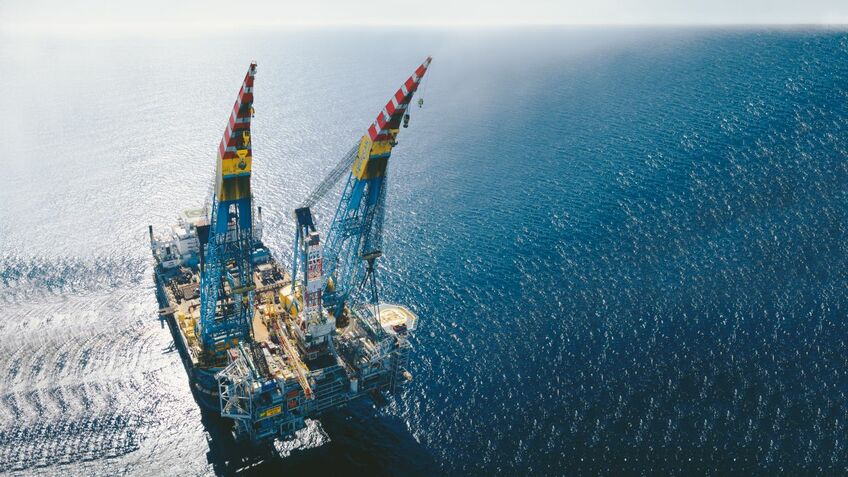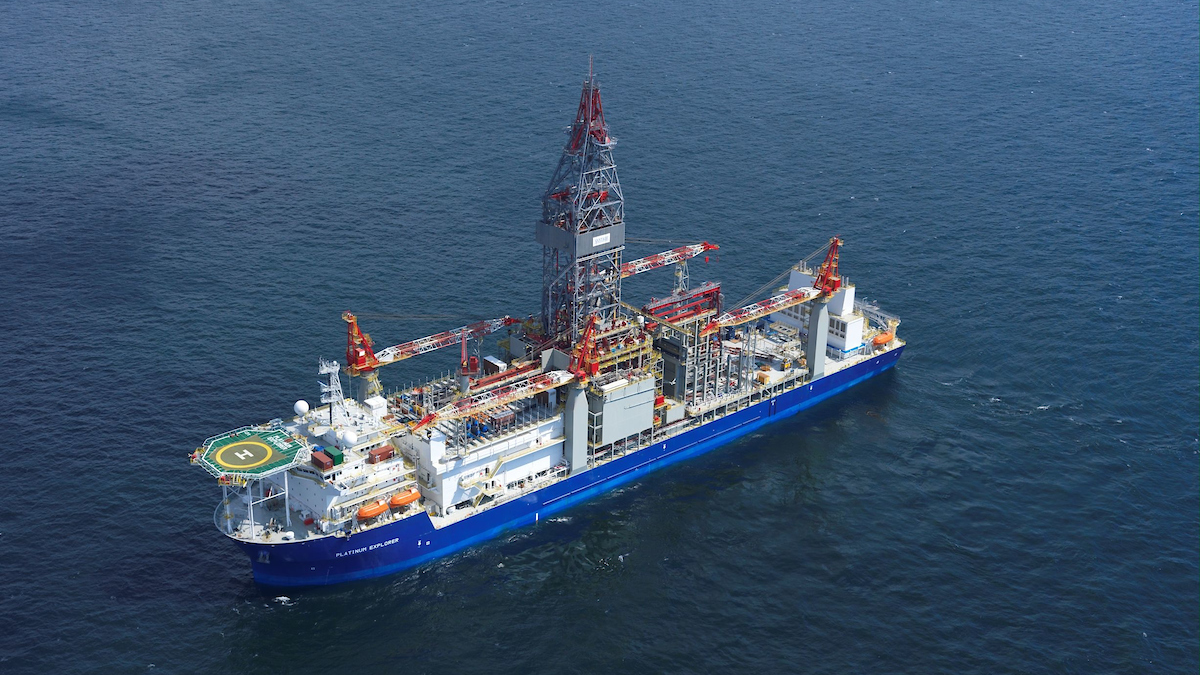Business Sectors
Events
Contents
New PSV was designed with future requirements in mind
Highland Prince represents what Gulf Offshore describes as a new breed of PSV that reflects the owner’s commitment to the industry in which it operates through the well-being of its people, the environment and its customers. STX Europe built the vessel after designing it in close co-operation with the customer. Its development is the result of an in-depth analysis of what the support vessel market will require in the future, focusing on safety, environmental efficiency, technical innovation and reliability. The PSV 09 CD design has also taken into account the well-being and comfort of its crew by furthering some of the concepts enshrined in Gulf Offshore’s Highland Prestige, another STX Europe design, delivered in 2007. This commitment to the environment is apparent in a PSV that carries, alongside other standard notations, the additions Clean Design or CD Notation, Comfort Class V3 and Naut OSV A Class. In choosing Clean Design CD Notation the company has met and exceeded the regulatory requirements for a PSV of this size (CD notation demands that the vessel is double-skinned to provide substantial protection against a pollution incident in the event of a hull breach).
In addition to the complex structural configuration, the underwater profile deviates substantially from that of a conventional PSV. This departure from the norm reduces the residual friction and wave resistance to an absolute minimum, which allows the vessel to make way in the most cost-efficient manner.
Choosing to combine a sleek underwater profile with Azipull propellers and a diesel-electric propulsion system of extremely high efficiency, Gulf Offshore ensured the vessel has minimum fuel consumption, minimal environmental impact along with maximum manoeuvrability and a respectable top speed. Integral to the propulsion system are selective catalytic reduction (SCR) units on all main engines. These fully align with Gulf Offshore’s ISO 14001 credentials, reducing harmful emissions so that the vessel achieves emission levels well below the demands of current regulations.
“Crew and client well-being are extremely important to Gulf,” the company’s managing director Perry Kennedy told OSJ, “especially when working within a harsh environment. Hence the decision to embrace Comfort Class, which supports our objective of creating an environment that protects those on board against the effects of noise-induced fatigue.” Innovative design has produced a ‘cocooned’ structure in which noise and vibration are so low that they undercut the acceptable levels set by regulatory and classification bodies today.
As Gulf Offshore highlights, the comfort of the crew is paramount to the operational effectiveness of the vessel. Highland Prince exceeds the requirements of Comfort V3 classification. “Working with the designers the root causes of noise and vibration were tackled using new technology and creative thinking,” Mr Brown told OSJ.
“The key to a calm and quiet environment for the crew to live and work in is in achieving acceptable noise and vibration levels. The living quarters were isolated from the main deck of the vessel by the creative use of space and the radical positioning of the emergency generator on the monkey island. In addition, a vibration analysis program, which injects the prevailing frequencies of the equipment fitted to the vessel into the structure, identified the vibration resonance areas, which were then designed out.”
Actual noise levels in transit are 30 per cent lower than the maximum values allowed, which for vibration on transit or manoeuvring is 5mm/second in any plane. The vessel has averaged 0.2mm/second on transit and 0.5mm/second when manoeuvring.
Naut OSV A is a notation that supports the company’s commitment to operational excellence and the well-being of its crew and clients, and produces an exceptional ergonomic layout in the command area of the vessel (the bridge).
Gulf Offshore’s innovative approach to ergonomic considerations also provides fingertip access to all navigational and charting aids, stability controls and marine communications, all allowing for safer, infield operations.
Highland Prince looks different too at first glance compared with a conventional PSV. Its striking lines are not only pleasing to the eye but also contribute to a high volumetric efficiency. Tankage takes up a massive 62 per cent of available hullform.
The vessel also has an enclosed forecastle deck area that contributes to the streamlined, low-resistance hull and provides a safe working environment for crew operations. The fully covered main deck cargo rails and discharge/loading stations placed amidships as well as aft ensure that Highland Prince is not only efficient but also provides safe working conditions for its crew.
The forecastle deck area also provides a great wind advantage, enhancing the vessel’s DP footprint and providing a controlled and protected area for crew operations at sea. The truly double-hull design provides enhanced pollution protection with oil and other potential pollutant storage tanks well within the inner hull and out of double bottom or side tanks.
Rather than using conventional propellers, Highland Prince employs a pair of 2.2MW variable pitch, variable speed Azipull propulsors aft and 2 x 880kW fixed pitch, variable speed, reversible bow thrusters. The vessel’s power system is fully flexible and redundant with multiple configurations of generator and thruster consumer solutions available.
Gulf Offshore used the Azipull units after tests identified a 4 per cent greater efficiency over pushing units. Terry Brown, the company’s technical manager, said: “The advantage of these propulsion units against others in their class was maximised by the hull design at the stern, ensuring the pulling configuration was not restricted by the available water to the propeller.
“The inclination of the units enables them to ‘grab’ as much clean water as possible as supplied by the bulbous bow, which suppresses the bow wave,” he explained.
“These units are extremely effective whilst manoeuvring, due to the fin rudder with which they are fitted, and, in some conditions, these are considered to be steerable by the small fin.
The Kongsberg class 2 DP system controls the vessel in a predictive ‘Green’ mode, allowing the precise use of sufficient thrust to maintain station whilst conserving power and reducing emissions.”
When it comes to maintenance and upgrades the DP system on Highland Prince and the fully integrated vessel management system (VMS) can be interrogated by satellite link ashore.
The VMS allows the vessel to operate in controlled parameters in a fully automated state, managing all of the vessel’s systems, including realtime review of electronic tank gauging, generator management, propulsion control and alarm logging systems.
From a nautical safety perspective, the vessel is classed under the latest Naut OSV (A) to reduce the risk of failure in bridge operation, which could cause collision, grounding and heavy weather damage.
In addition Highland Prince is the first offshore support vessel to fully comply with the UK flag requirements for the implementation of an ecdis. An onboard CCTV system on the new PSV provides an effective aid to manoeuvring. The monitors are in strategic positions – forward and aft on the bridge – to provide comprehensive coverage. Highland Prince has eight oval, high-capacity mud tanks that have minimal obstructions and protuberances. Their careful design allows the effective discharge of mud cargo. In addition are two individual stainless steel methanol tanks with independent pumping and discharge stations located aft in an EX zone.
The vessel has a fully self-contained integral mud/brine tank cleaning system (see box) that employs hot water, the temperature of which is maintained by the main generator’s waste heat.
This system is completely automatic; it requires no internal intervention from crew or shore manpower. All tanks can be effectively cleaned and all slops processed to dirty water with the mud solids removed to deck.
To comply with ever increasing tank changes and configurations, the vessel includes an integrated Autoload stability programme with tank tender system. Whilst not mandatory, the large volume of ballast tank space in the vessel is protected by the application of the DNV COAT-PSPC (B). Moving towards the outer skin of the vessel, surface treatment of the ballast tank is enhanced by means of increased paint film thickness and quality to preserve the vessel’s internal ballast tank structures.
Recognising the fast-approaching requirements for vessels to process all ballast water on load and discharge, Gulf Offshore has designed Highland Prince to be fitted with preparations for ballast water treatment systems. Environmental requirements focus on low emissions of NOx and SOx into the air. These are achieved by efficient engine combustion and the fitting of the selective catalytic reduction (SCR) units to the four main generators. This system guarantees the NOx limit of 1.5g/kWh, the lowest figure an ‘off engine’ system can achieve.
Highland Prince in brief
• double-skinned hull provides additional protection against pollution in the event of a hull breach
• sleek hull, variable direction/speed Azipull propellers and high-efficiency diesel-electric propulsion system ensures minimum fuel consumption with maximum manoeuvrability
• flexible switchboards enable multiple configuration generator and thruster solutions
• low levels of NOx and SOx emissions to air are achieved by improved combustion efficiencies and the use of SCR units fitted to the four main generator engines
• hybrid tank cleaning system developed by Gulf can save clients time and money over the duration of a charter. Cleaning the tanks whilst at sea removes the need for expensive tank cleaning squads and reduces port turnaround time
• the vessel conforms to Comfort Class V3 for noise and vibration limits, providing a calm and safe environment in which to work
• enclosed forecastle deck area provides a safe working environment for crew and contributes to streamlined, low-resistance hull. The ship also benefits from fully covered main deck cargo rails with discharge/loading stations amidships as well as at the stern.
• first offshore support vessel to fully comply with the UK flag requirements for the implementation of an electronic chart display system (ecdis).
New PSV has hybrid tank cleaning system
Gulf Offshore’s new PSV Highland Prince is a groundbreaking vessel in a number of respects, not least because of its proprietary new hybrid tank cleaning system, which the company believes can save its clients time and money over the duration of a charter.
In the fully self-contained integral mud/brine tank cleaning system on board Highland Prince, which uses water heated by waste heat from the main generator, the tank cleaning process is semi-automatic. No internal intervention is needed from the ship’s crew.
Cleaning the tanks this way while at sea removes the need for expensive tank cleaning squads and reduces port turnaround time. All of the tanks can be effectively cleaned and all slops processed to dirty water with the mud solids removed to deck.
The newbuild team at Gulf Offshore designed and developed the system over several years with assistance from Gulf’s operations department and a proactive crew with hands-on operational experience. The hybrid tank cleaning system is not an off-the-shelf product but has been created from many different, well researched and tested pieces of equipment, including pump vortex eductors, heaters, mixers and tank cleaning heads.
Gulf Offshore highlights the importance of the coating system for the tanks, which ensures that surfaces are smooth. This lack of protrusions creates a friction-free surface for the mud to slide off. The detailed design of the tanks was also particularly important, as was reducing shadow areas by using round instead of flat bar for flanges on longitudinal girders, and by using an increased rise in floor angles to improve liquid flow into the suction well.
Deliverable advantages of fitting this system include:
• safety: an 80 per cent reduction in exposure hours of manual tank cleaners can be achieved. Recent history has highlighted the extreme dangers of entering and working in enclosed spaces. With Gulf Offshore’s new system, manual cleaning is now only required when cleaning to complete brine standard
• environmental advantages: tank washings have been reduced by more than 70 per cent of historical volumes as the in-situ tank cleaning systems are able to use hot water, and this is also recycled. This leads to a reduction in residues. There is also less waste water than is the case with high-pressure jetting units. Gulf Offshore is able to separate the solids completely to deck reception facilities by using a horizontal back feed decanter. Waste heat recovery from the main generators on board provides enough heat to completely wash and process the fluid from all of the cargo tanks. This results in a reduced pollution risk because the system is closed and self-contained. Pumping of waste water to quayside reception is also closed and solids are contained in slurry skips lifted ashore
• effective cost savings: as the vessel can be cleaned in transit rather than at the quayside, the port turnaround time can be cut significantly, thus increasing the effective utilisation time of the vessel. Waste heat recovery saving is of the order of 1,200kW of power. Water washings traditionally go to landfill and the government is working towards higher targets and tariffs to these sites, which could greatly increase costs to the contractor. Gulf Offshore’s ability to minimise the quantity of wash water is therefore also very cost-effective. Avoiding chemicals in the wash water allows the separation of the process fluid to be even more efficient. With careful planning of cargo load out and returns the need for costly shore-based intervention can be significantly reduced. OSJ
Related to this Story
Women in Maritime Today: Elin Saltkjel says no day working in maritime is dull
Events
Maritime Environmental Protection Webinar Week
Cyber & Vessel Security Webinar Week
The illusion of safety: what we're getting wrong about crews, tech, and fatigue
Responsible Ship Recycling Forum 2025
© 2024 Riviera Maritime Media Ltd.













